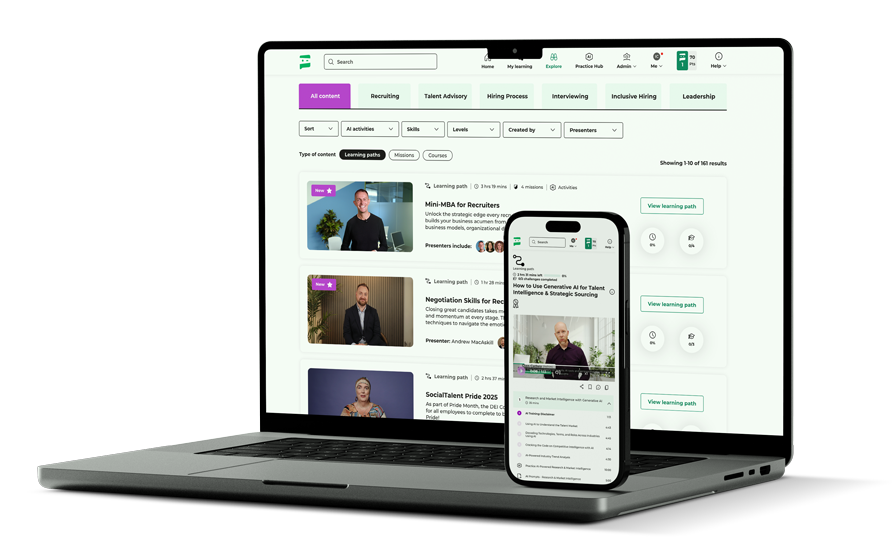
By Johnny Campbell
I was listening to the Prof G Markets podcast last week, specifically their episode “How The AI Economy Could Collapse” and found myself nodding along to every concerning data point they raised.
OpenAI just closed a $40 billion funding round at a $300 billion valuation. Anthropic raised $13 billion earlier this quarter. Thinking Machines (a company started by OpenAI’s former CTO that doesn’t even have a product yet) raised $2 billion at a $10-12 billion valuation in their Series A. Q3 venture capital saw significant growth year-over-year, with mega-rounds concentrated almost entirely in AI and hardware.
If you’re a TA leader watching this unfold and thinking, “This feels… off,” you’re not wrong. This has all the hallmarks of a bubble. And if you’re nervous about making AI investments for your recruiting tech stack right now? You’re not alone.
But here’s what you need to understand:
Don’t confuse the AI investment hype with AI hype. AI works. The tools deliver real value. The ROI is measurable. But the money flowing into AI companies right now is creating dangerous dynamics that could leave your organization high and dry if you’re not paying attention.
Let me explain what’s actually happening, and what you should do about it.
The Bubble We’re In (And Why It Matters to You)
We’ve been here before. Twice, actually.
The DotCom Bubble (2000-2001): All the money concentrated in internet infrastructure – Cisco was the most valuable company in the world. Then the bubble burst. Infrastructure companies crashed. But the real value of the internet? That came later, from the companies that built ON the infrastructure: Amazon, Google, Facebook. They emerged after the crash and changed everything.
The Housing Crisis (2008): Over-leveraged investments, complex financial instruments, and a belief that things could only go up. Until they didn’t.
Now look at today’s AI landscape:
The US stock market is heavily concentrated in the “Magnificent 7” (Alphabet, Amazon, Apple, Broadcom, Meta, Microsoft, and NVIDIA). These companies represent a massive portion of market value, and they’re all betting big on AI infrastructure.
Meanwhile, AI startups are raising absurd amounts of money at valuations that make no sense if you look at their revenue, profitability, or even product readiness. We’re seeing circular investments (OpenAI and NVIDIA investing in each other’s ecosystems), mega-rounds for companies without proven business models, and a feeding frenzy that’s eerily reminiscent of 1999.
Just like the DotCom era, all the money is stuck in infrastructure – data centers, GPUs, foundational models – because of capacity constraints and limited suppliers. The real value creators (the companies building practical AI applications that actually solve business problems) are still emerging. But if the bubble bursts before they get established, it could kill their development.
And here’s where it hits your world: if you’ve invested in AI recruiting tools from vendors who suddenly go under or get fire-sold in an acquisition, you could lose that investment, your data, and your operational capability overnight.
The Real Risk: VC Dependency
Here’s what should actually concern you when evaluating AI vendors: Not whether AI works (it does), but whether your vendor will still exist in 12 months.
The AI market right now is full of companies that are burning through VC money with no clear path to profitability. They’re not selling what they make (proving product-market fit). They’re raising rounds to fund growth, burning cash, and depending on the next funding round to survive.
What happens if the VC funding suddenly stops? What if investors start calling back their money? What if the market corrects and these companies can’t raise their next round? Your recruiting operations get left in the lurch.
Compare that to vendors who are self-funded and profitable from revenue, part of established companies with liquid cash and diversified revenue streams, or revenue-generating with proven product-market fit (even if they’re still using VC to accelerate growth). These vendors evolved their AI offerings from positions of industry strength. They’re not betting their survival on endless funding rounds.
A Framework for Vendor Financial Stability
When you’re evaluating AI recruiting tools right now, you need to assess financial risk alongside product capability. Here’s how:
High Risk: VC-Dependent Startups
Red Flags:
- Multiple funding rounds in quick succession
- No clear revenue model or path to profitability
- Burn rate that suggests they need to raise again within 12 months
- “Growth at all costs” messaging
Questions to Ask:
- What’s your current runway?
- When was your last funding round and when do you expect to raise again?
- What percentage of revenue comes from paying customers vs. investors?
- What’s your path to profitability?
Medium Risk: Revenue-Generating But VC-Backed
Yellow Flags:
- Paying customers but still dependent on VC for growth
- Recent large rounds that suggest they’re not self-sustaining yet
- Aggressive expansion that outpaces revenue growth
Questions to Ask:
- What’s your customer retention rate?
- How much of your growth is organic vs. funded?
- What happens to product development if you don’t raise your next round?
Lower Risk: Self-Sustaining or Established
Green Flags:
- Profitable or part of a larger company with diversified revenue
- Long runway without needing additional funding
- Organic growth from product-market fit
- Evolution of existing product line (not a greenfield bet)
Questions to Ask:
- What’s your long-term product roadmap independent of market conditions?
- How is this product funded within your organization?
- What’s the strategic priority of this product line?
What Buyers Should Actually Do Right Now
Here’s where most organizations are getting it wrong: they’re freezing ALL AI investment out of fear of the bubble. That’s the worst possible move.
While you’re paralyzed by analysis, your competitors are moving forward – smartly, strategically, but definitely moving. The window to gain competitive advantage is now. But you need to be discerning about where you place your bets.
1. Separate Hype From Value
AI absolutely delivers value in recruiting:
- Faster screening without sacrificing quality
- Better candidate matching
- Reduced bias through structured processes
- Improved interviewer performance through intelligence tools
- Predictive insights on hiring outcomes
The tools work. The ROI is real. Don’t let the investment bubble scare you away from legitimate solutions.
2. Prioritize Vendor Stability Over Cutting-Edge Features
The sexiest, most advanced AI tool in the world is worthless if the company goes under in six months.
Ask yourself: Would I rather have 90% of the capability from a stable vendor, or 100% of the capability from a company that might not exist next year?
Safe and reliable beats cutting-edge and risky in your core hiring infrastructure.
3. Build Optionality Into Your Stack
Don’t get locked into single-vendor dependencies where you can’t export your data or switch providers.
Ensure:
- Data portability (you own your data and can extract it)
- API integrations (you can swap components)
- Clear exit strategies (what happens if you need to leave?)
In an unstable market, flexibility is a feature, not a nice-to-have.
4. Focus on Established Players for Core Infrastructure
Your ATS, your HRIS, your foundational systems? Stick with established vendors who aren’t going anywhere.
Save your bets on newer, VC-backed vendors for:
- Point solutions you can swap out easily
- Experimental tools with limited scope
- Nice-to-have enhancements, not mission-critical operations
5. Create a Vendor Health Monitoring Process
Don’t just evaluate vendors at purchase. Monitor them quarterly:
- Are they raising new rounds? (Could signal instability)
- Are they getting acquired? (Could change everything)
- Are customers churning? (Check reviews, talk to peers)
- Are they pivoting products? (Your tool might get sunset)
The Contrarian Take: This Might Be the BEST Time to Invest
Here’s what most people aren’t saying: market instability creates opportunities.
When the AI bubble eventually corrects (and it will), several things will happen:
Weak players will fail. The companies with no business model, no product-market fit, and no path to profitability will disappear. Good riddance.
Strong solutions will emerge. The vendors who survive will be the ones solving real problems for real customers. These are the ones you want to work with anyway.
Prices will normalize. Right now, AI vendors can charge whatever they want because of FOMO. When the hype cools, you’ll have more negotiating leverage.
Talent will shift. When VC-backed startups fail, talented people will move to sustainable companies or start new ventures with lessons learned.
If you wait until everything stabilizes, you’ll be late. The organizations that move now – strategically, carefully, but decisively – will have built their AI capabilities while everyone else was frozen in fear.
Don’t Confuse Caution With Paralysis
Look, I get it. The AI investment landscape is wild right now. $40 billion rounds for companies that might not be profitable for years (if ever) is not normal. The Magnificent 7 concentration risk is real. The parallels to DotCom and 2008 are uncomfortable.
But here’s what you can’t do: let fear of the bubble prevent you from building the capabilities your organization needs. AI in recruiting isn’t going away. The tools work. The competitive advantage is real. The question isn’t WHETHER to invest – it’s HOW to invest wisely.
So do your due diligence. Ask hard questions about vendor stability. Build optionality into your stack. Favor established players for critical infrastructure. Monitor vendor health continuously.
But don’t sit still.
Because while you’re waiting for perfect clarity, the market is moving. And the companies that figure out how to navigate this chaos strategically? They’re going to pull ahead.
The AI investment bubble will eventually pop. Some vendors will fail. Some will get acquired. Some will emerge stronger.
Your job is to make sure you’re betting on the ones in that last category.
How is your organization navigating AI vendor decisions in this environment? What due diligence are you doing on vendor financial stability?



